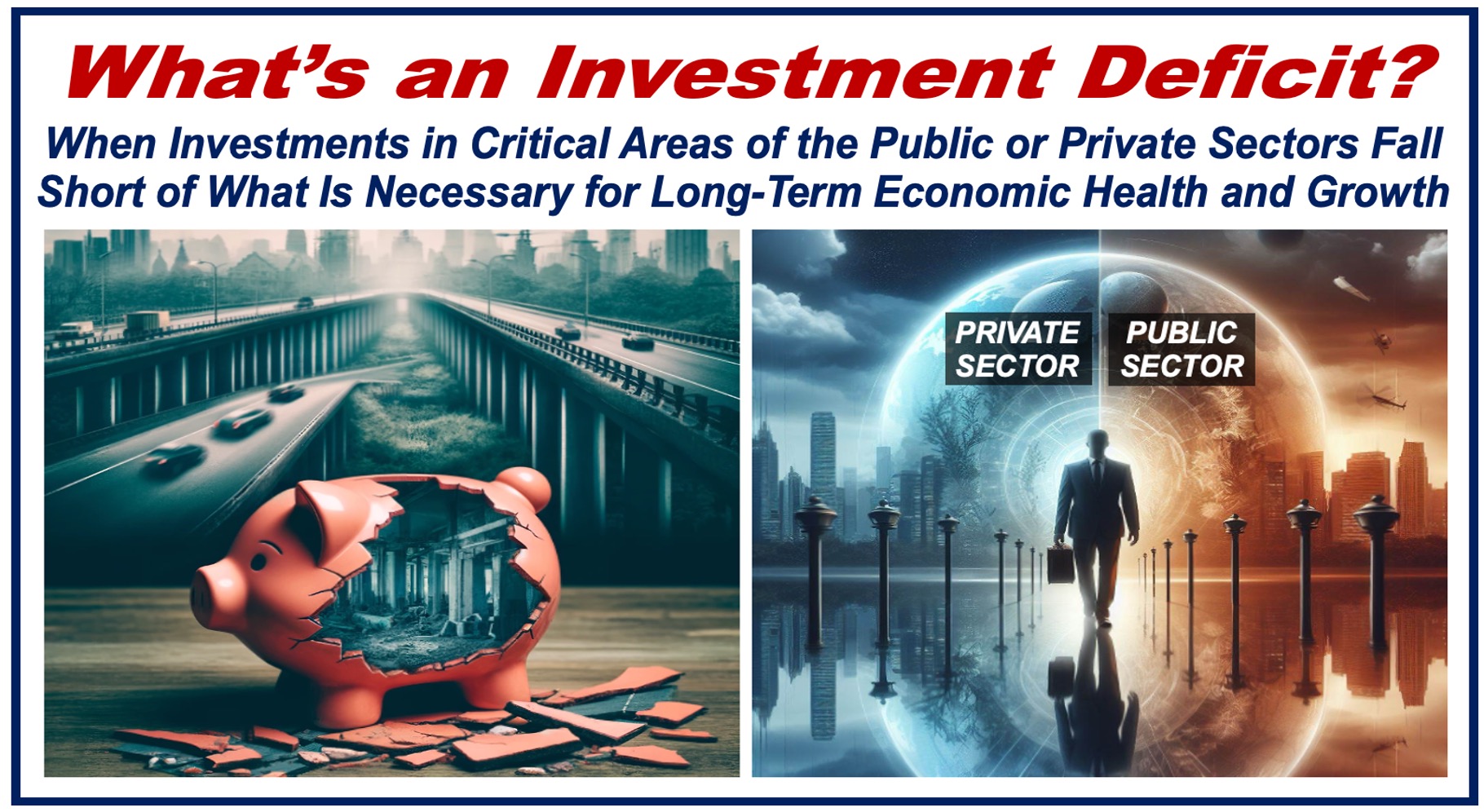We say there is an Investment Deficit when there is a noticeable lack of investment in essential areas that drive growth and productivity.
We can use the term when talking about a business or the economy of an entire country.
When talking about investments at the national or government level, we often use the term “public investment deficit.” In an Economic Policy Institute essay, Dean Baker explains that since the late 1970s, there has been a growing public investment deficit in the United States.
Two components – ‘investment’ and ‘deficit’
To fully understand the term “investment deficit,” it helps to break it down into its two components: “investment” and “deficit.”
-
Investment
Investment involves allocating resources – usually money or time – to projects that we expect to yield future benefits. This can be done by individual people, companies, or governments.
If you buy stocks (shares) and hope that their value will increase over the next two, five, or more years, you are investing.
The key goal of any investor is to generate returns, such as financial profits, greater productivity, or infrastructure improvements.
-
Deficit
A deficit describes a shortage or negative result. If a country imports more than it exports, it has a trade deficit. If a government spends more than it earns in taxes, it has a fiscal deficit.
Other examples include budget deficits, current account deficits, capital deficits, savings deficits, production deficits, and primary balance deficits. The opposite of a deficit is a surplus (excess).

Investment deficit – companies
-
At company level
In the context of a company, an investment deficit means not allocating enough resources to critical areas like staff training, technology, or new product development.
A business may cut back on these investments because it does not have enough money or is focused on maximizing short-term profits.
If the investment deficit continues, it may find it harder to grow, become more productive and efficient, and compete in today’s fiercely competitive marketplace.
-
At national level
For a country, an investment deficit typically refers to underinvestment in infrastructure, such as roads, schools, hospitals, bridges, airports, and ports. The term may also refer to a lack of investment in sectors that are crucial for long-term growth like science and technology.
Governments may invest less because their budgets are limited, political challenges, or other economic pressures.
A lack of investment in these critical areas can lead to broader issues, such as reduced economic output, lower quality of life, and fewer employment opportunities.
Consequences of investment deficits
-
In the business world
A company that does not or cannot invest appropriately could end up with outdated processes and products, decreased market share, and lower profits.
-
In the national economy
The repercussions for countries can be even more severe. The nation’s economic stability and citizens’ standard of living may suffer. Roads, bridges, and tunnels may deteriorate; schools may lack necessary supplies; and healthcare facilities may become outdated.
Strategies to overcome investment shortfalls
In both the corporate world and the public sector, addressing an investment deficit requires strategic planning and decisive action:
-
The private sector
Businesses need to take a critical look at their investment strategies. They must find a way to allocate enough funds to areas that will help the company grow sustainably over the long term.
This might involve investing in new technologies, expanding into new markets, enhancing research and development efforts, diversifying product lines, improving employee skills through training programs, or increasing capital expenditures for long-term assets.
For many companies today, especially businesses in tech, finance, and healthcare, AI (artificial intelligence) has become an essential investment to stay competitive.
-
The public sector
The government must implement policies that encourage investment in essential sectors. This may include boosting public spending on infrastructure, offering incentives for private investments in research and development, subsidizing emerging industries, reforming tax policies to favor investment, partnering with private entities for public projects, investing in education to foster a skilled workforce, or creating a more favorable regulatory environment for business expansion and innovation.
Final thoughts
An investment deficit is an investment shortfall. The term can be used for companies and the whole economy.
For a business or country to be able to compete effectively in today’s rapidly changing world, ensuring adequate investment is crucial.
Without the right level of investment, it is not possible to harness the latest innovations or respond effectively to new challenges.
